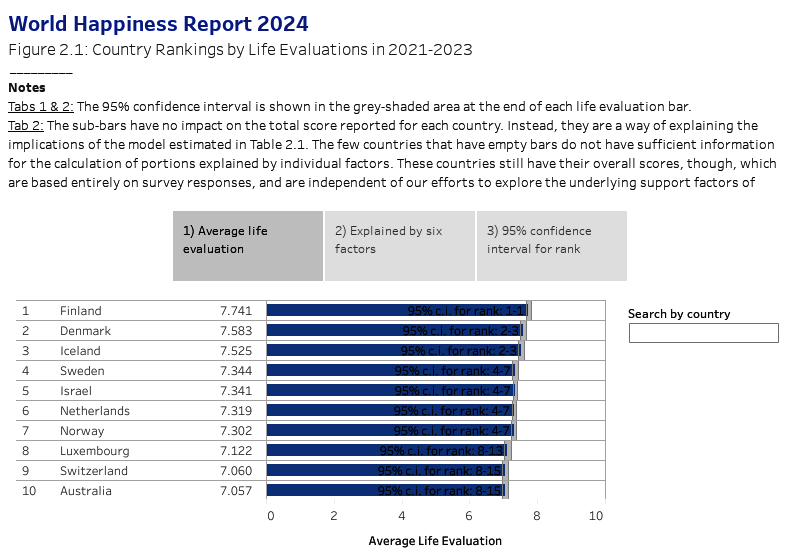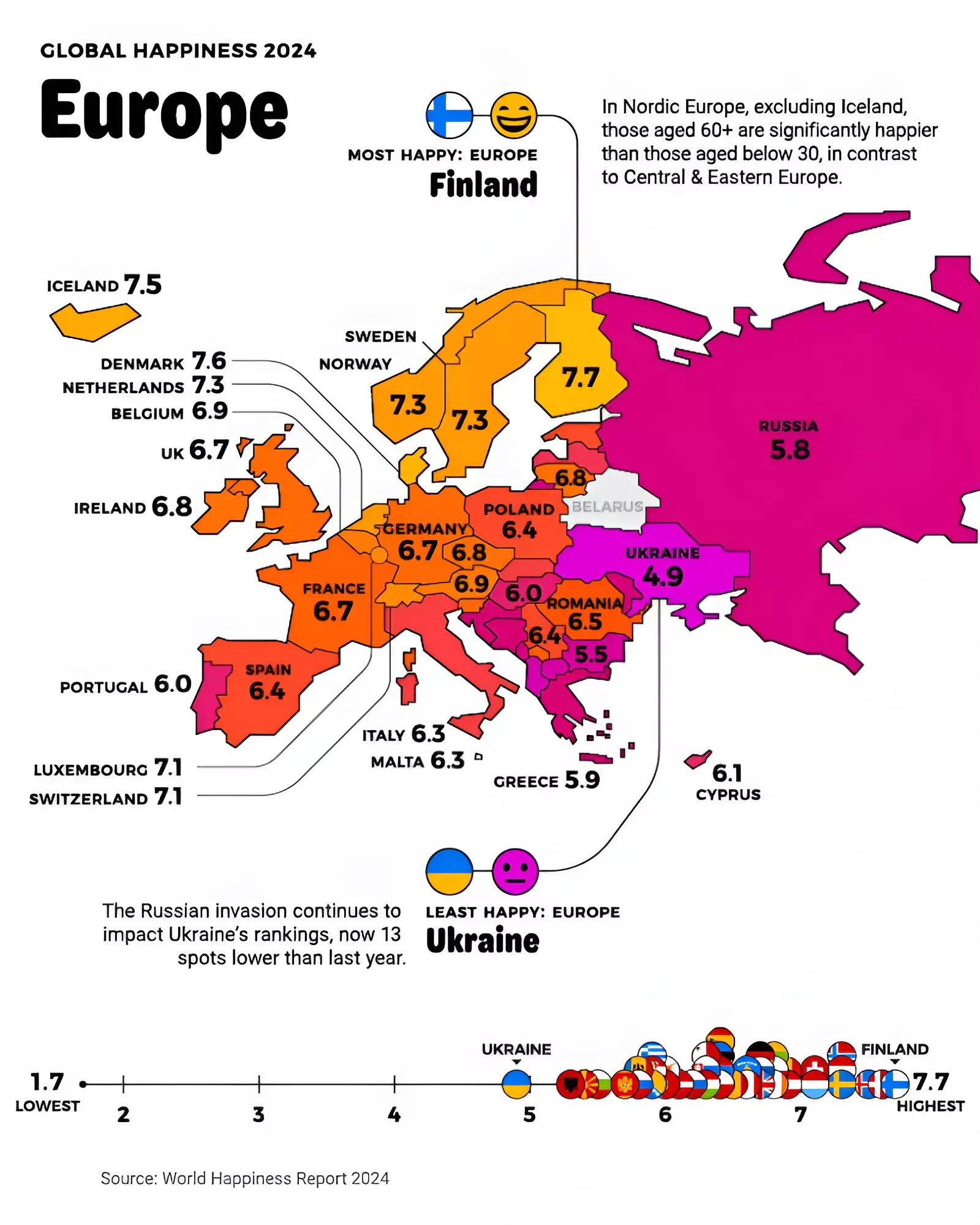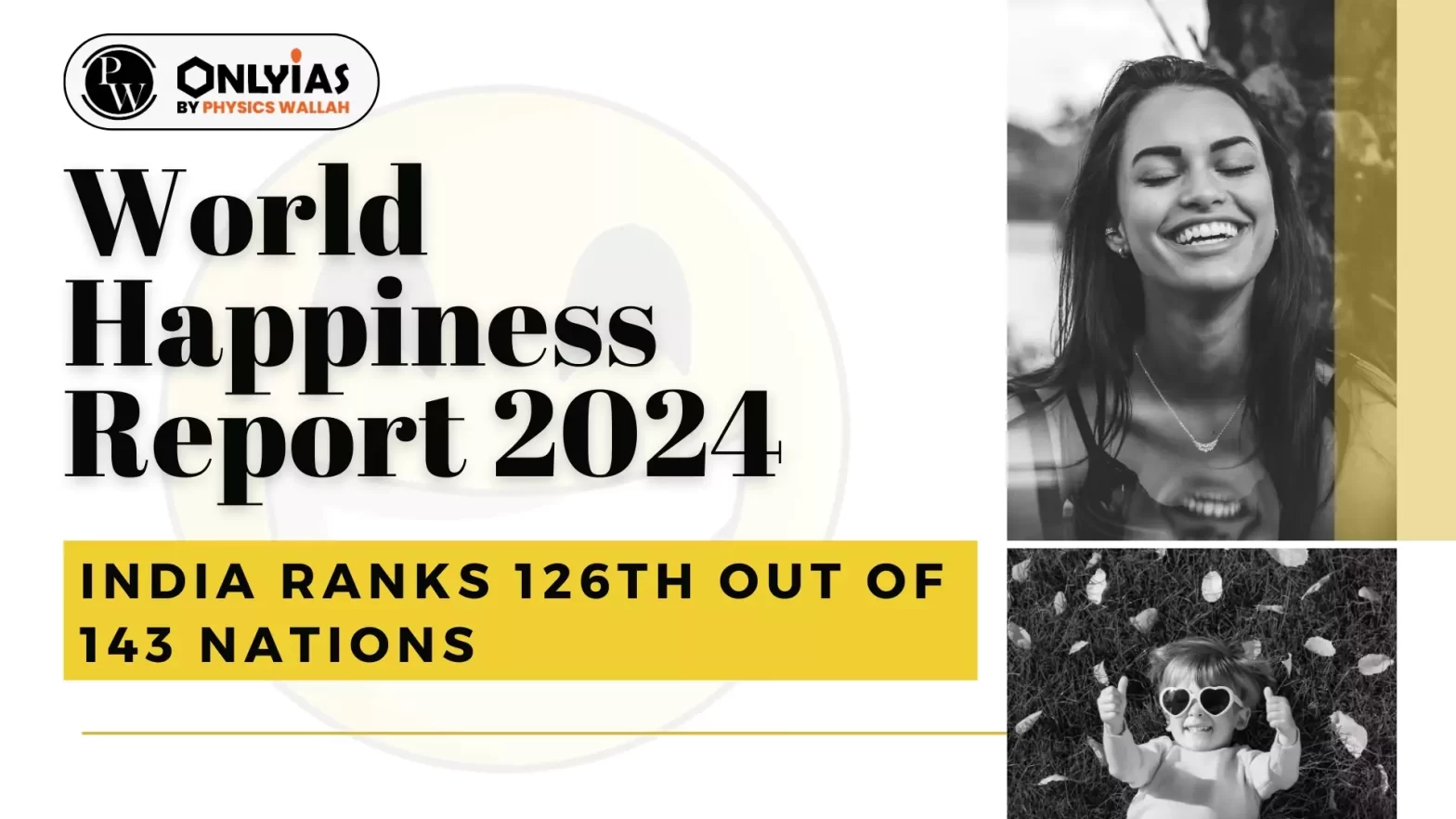Context
Recently, the United Nations Sustainable Development Solutions Network released the World Happiness Report 2024 which ranks countries on the basis of happiness.
- The International Monetary Fund concurred that while GDP per capita is a “significant predictor of happiness, but it’s not the only factor”.
- “Variables including social support, life expectancy, freedom, generosity, and the absence of corruption” explain the happiness of countries.
About World Happiness Report
- An Annual Report: It is an annual report that evaluates happiness levels across more than 140 nations and is published in celebration of the International Day of Happiness (March 20).
- The rankings are from nationally representative samples over three years.
- Six Considered Factors: Social support, income (GDP per capita), health, freedom, generosity and the absence of corruption.
- Use of Cantril ladder: They also measured people’s life satisfaction, through a self-assessed evaluation tool called the Cantril ladder.
- The Cantril Ladder asks respondents to think of a ladder, with the best possible life for them being a 10 and the worst possible life being a 0.
- Source of Data: Data is sourced from various outlets, including the Gallup World Poll.
- Collaborators include the UN Sustainable Development Solutions Network, Gallup, and the Oxford Wellbeing Research Centre.
- Significance: It reflects a worldwide demand for more attention to happiness and well-being as criteria for government policy. It reviews the state of happiness in the world today and shows how the science of happiness explains personal and national variations in happiness.
Enroll now for UPSC Online Course
About International Happiness Day
- Observed On: 20th March every year.
- Established: By the United Nations General Assembly on 28 June 2012, to make people around the world realise the importance of happiness within their lives.
- Theme 2024: “Reconnecting for Happiness: Building Resilient Communities”
- Significance: It focuses on highlighting the meaning of happiness in making objectives and aspirations for individuals and driving them to have a better life. It likewise promotes sustainable development, general prosperity and elimination of poverty.
- Background: The General Assembly of the United Nations in its resolution 66/281 of 12 July 2012 proclaimed 20 March the International Day of Happiness.
- The resolution was initiated by Bhutan, a country which recognized the value of national happiness over national income since the early 1970s and famously adopted the goal of Gross National Happiness over Gross National Product.
About Sustainable Development Solutions Network (SDSN):
- It is a non-profit created in 2012 by the United Nations to promote the 17 Sustainable Development Goals at national and international levels.
- Establishment: It was established under the auspices of the United Nations Secretary-General.
|
World Happiness Report 2024: Key Highlights

-
Top Happiest Countries in the World:
- Worldwide: Finland, Denmark, Iceland, Sweden, Israel, Netherlands, Norway, Luxembourg, Switzerland and Australia.
- The top 10 countries in the list have remained the same since before the Covid-19 pandemic.
- In Asia: Singapore, Taiwan, Japan, South Korea, Philippines, Vietnam, Thailand, Malaysia, China and Mongolia.
-
Nordic Countries Dominate Top Ranks:
-
- Finland, Denmark and Iceland retain their top positions at first, second and third place, respectively. Sweden followed closely at fourth.
- Costa Rica and Lithuania have broken into the top 20 list for the first time, securing ranks 12 and 19, respectively.

-
Afghanistan Remains Least Happy Country:
- Afghanistan retained its status as the unhappiest country in the world followed by Lebanon, Lesotho, Sierra Leone and Congo.
-
A High (5th) Rank Secured by Israel:
- Despite ongoing conflicts, Israel secures the fifth position in the report.
- Reason: It is due to the three-year averaging method used in the rankings, which mitigates the immediate impact of cataclysmic events such as the war with Hamas.
- A cataclysmic event is one that changes a situation or society very greatly, especially in an unpleasant way.
-
Noticeable Shifts:
-
- For the first time, happiest nations no longer include any of the world’s largest countries, with only the Netherlands and Australia with populations exceeding 15 million within the top 10, and Canada and the UK with populations over 30 million within the top 20.
- The U.S. missed in the top 20 list, a first in 12 years of the report’s publication.
-
Benevolence Levels:
- It means how likely people are to help others in need, as feelings of social support factor into life satisfaction.
- There is a post-COVID increase in how benevolent people are across all generations, particularly those born after 1980, the Millennials and Generation Z “who are even more likely than their predecessors to help others in need”.
-
A Shift in Happiness Dynamics:
-
- Denmark, Finland, Norway, Sweden and Iceland (all Nordic nations), ranked the highest, while the opposite trend was observed in Portugal and Greece.
India’s Rank in World Happiness Report 2024
- India ranked at 126 place (same as last year).
- India lags behind its neighbouring countries like China at 60, followed by Nepal at 93, Pakistan at 108 and Myanmar at 118.
- Aged 30 and Below: India ranked at 127th spot.
- India’s Position on Elder Population:
- India holds the second position (only after China) globally in terms of its elderly population, with 140 million individuals aged 60 and above.
- While this demographic shift signifies advancements in social and economic spheres, comprehending the factors that impact the quality of life during old age remains paramount.
|
-
- Aged 60 and Above: India ranked at 121st spot. Here, older age is associated with higher life satisfaction.
- Older Indian Women: They tend to report higher life satisfaction compared to men, despite facing more stressors and health challenges.
- Older Indian Men: Particularly those in higher age brackets, presently married, and those with an education, tend to report greater life satisfaction compared to their counterparts.
- Numerous elements, including marital status, social interaction, and physical well-being, impact the life contentment of elderly Indians.
- Women often have broader social networks.
- Among older Indians, factors such as dissatisfaction with living arrangements, perceived discrimination and poor self-rated health are linked to lower life satisfaction.
- Correlation Between Caste Divisions And Life Satisfaction: It highlights that life satisfaction was higher among non-schedule caste (SC) and non-schedule-tribe (ST) than their SC-ST peers.
- Impact of Education & Caste: Education and caste played key roles, with older adults with higher education and those of higher social castes reporting higher life satisfaction than their counterparts without formal education and those from SCs and STs.
- Regional Variations: Regionally, older adults from Western parts of India were much happier than those living in north-eastern or central regions.
Enroll now for UPSC Online Classes
Arising Concerns in the World Happiness Report
- Widening Gap: Worldwide, women were less happy than men in every region, with the gender gap widening as they aged.
- The report raises concerns regarding the escalating disparity in happiness worldwide, particularly among older individuals and in Sub-Saharan Africa, highlighting discrepancies in income, education, healthcare, and social support systems.
- Happiness inequality is widening in every region except Europe, increasing by more than 20% over the past dozen years.
- Happiness Trends among Different Age Groups: This was the first edition that looked at the intersectionality of life satisfaction with age and generations.
- Aged 30 and Below: Lithuania, Israel, Serbia, Iceland and Denmark ranked in the top five, with Finland at the seventh rank.
- Aged 60 and Above: Denmark claims the top spot for those over 60.
- Decline in Children’s Happiness: Alarmingly, the report highlights a decline in children’s happiness, particularly in North America and Western Europe.
- There is an urgent need for policy action to address this concerning trend.
Finland’s Actions Towards Top on the Happiness:
- Finland’s high life satisfaction to the residents’ strong connection to nature and a healthy work-life balance.
- They prioritise aspects beyond financial gain, benefitting from a robust welfare society, trust in government institutions, low corruption levels, and universal healthcare and education.
|
- Loneliness, a Significant Issue: Loneliness emerges as a significant issue, particularly in the US. Surprisingly, it is the younger generation, particularly Millennials, who report higher levels of loneliness compared to older demographics.
- Millennials: The term used to describe a person born between 1981 and 1996, though different sources can vary by a year or two.
Challenges Associated with the World Happiness Report
- Implicit Focus on Resources: The Report uses “happiness” and “life satisfaction” interchangeably, thus tying happiness scores with one’s access to economic and social resources.
- Department of Happiness: Madhya Pradesh is the first state in India to have a department solely dedicated to promoting happiness and well-being.
|
- Self-Declaration: Life satisfaction in the study is self-reported, thus there always remains the possibility of misreporting due to the fear of social stigma.
Conclusion
As rightly observed by the Dalai Lama, “the purpose of our lives is to be happy”, there is an urgent need to address all those issues which hamper happiness. India also needs to work upon in this direction by adopting the practices of Finland that help it to be on the top list and countering the challenges where India is lacking in this list. India needs to establish a Ministry of Happiness with academicians, economists, psychologists and social thinkers to map the road to happiness forever.
Also Read: Gender Pay Gap: World Bank Report
| Prelims PYQ (2018):
Increase is absolute and per capital real GNP do not connote a higher level of economic development, if
(a) industrial output fails to keep pace with agricultural output.
(b) agricultural output fails to keep pace with industrial output.
(c) poverty and unemployment increase.
(d) imports grow faster than exports.
Ans: (c) |
![]() 21 Mar 2024
21 Mar 2024



